I like to cry.
Maybe it’s not something a 32 year old married man should admit, but I appreciate a good cry.
It’s not like a hobby or anything. But if things are really weighing on me, I’ll youtube something sappy like soldiers returning home to surprise their kids, and let the waterworks flow. I read somewhere that emotional tears (as opposed to reflex tears) contain stress hormones which are excreted from the body through crying.
For this reason, I always loved tennis players who were willing to be open with their emotions.
Not in an angry, obnoxious kind of way. I always felt sympathy for umpires who were vocally abused by livid players after a controversial line call.
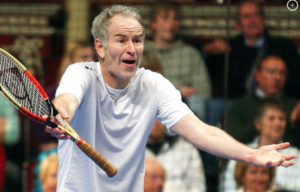
But if you were a tennis player, and I saw you cry, you had likely won a fan for life.
Maybe I was drawn to that player’s vulnerability. It made them feel like they were more human.
Maybe I was just a shy kid, who cried a lot in the first grade, and I immediately felt a sort of kinship with a person if I saw them doing the same.
Either way, when Pete Sampras broke down during the 5th set of his 1995 Australian Open Quarterfinals match with Jim Courier, I was immediately drawn to him.
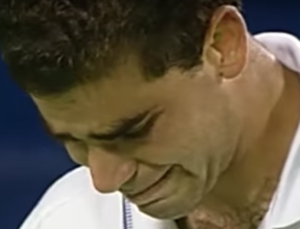
As a 9 year old, I didn’t know why Pete was crying. The truth is, it didn’t really matter.
I just saw someone who was emotionally exposed in front of thousands of people.
And I saw a player who had so much mental strength, and so much talent, that in between his tears, in between his sobs, he was still capable of playing spectacular tennis.
I became a Pete Sampras fan for life that day.
The ironic thing about Pete’s emotional breakdown was that he usually never displayed much emotion.
To Pete, someone who always expressed their emotions wasn’t a person with deeper emotions or someone who was more in touch with their inner selves. They were just someone who was less able to exert self-control.
Pete was reserved, and only allowed a select few to get to know him on a deeper level.
One of those people was Tim Gullikson.
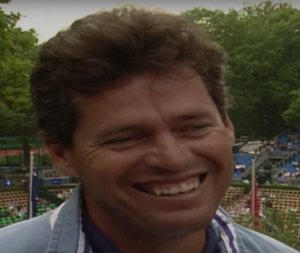
Tim became Pete’s coach in 1992. He had won 15 doubles titles in his career, with 10 of them coming with his twin brother Tom.
Yes, the Gullikson parents named their twin sons Tim and Tom.
Unlike Pete, Tim was extremely outgoing.
While many people around the men’s game felt like they didn’t really know Pete, everyone loved his coach.
“People really loved Gully,” said Andre Agassi. “He’s just this easy guy to like.”
Jim Courier said that “Tim was one of the most liked people in my time on the ATP Circuit. Everyone loved Gully.”
Everyone loved Gully.
Including Pete.
They went to dinner together, played cards together, teased each other, and were extremely close.

“He was so much more than just a coach.” Pete said. “He was my best friend and someone I’ve told a lot of things I’ve never told anyone.”
Under Tim’s tutelage, Pete won 4 Grand Slam singles titles in 1993 and 1994.
However, in the months leading up to the 1995 Australian Open, Tim’s health took a turn for the worse.
He had fainting episodes in October and December of 1994. Doctors diagnosed Tim as having suffered a couple of strokes, as well as having some heart concerns. Still, they didn’t have a definitive diagnosis.
Tim continued to work with Pete, and coached him at the Australian Open in 1995.
On January 20th, 1995, Tim was warming Pete up for his third round match when he began to feel drained. Before he knew it, his world began to spin.
His twin brother Tom took him to the hospital, where a brain scan was performed.
After more testing, a doctor told the Gullikson twins that Tim had melanoma of the brain, a severe cancer. He was told that he had three to six months to live. Tim broke down crying. (Tim later learnt that he did not have melanoma, but had four brain tumors.)
Tim decided not to tell Pete about his grave diagnosis at the time.
When Pete visited Tim at the hospital, the twins told Pete that Tim had gone through a variety of tests at a private clinic, and that he needed to fly home.
The Gulliksons tried to keep it together, and make small talk with Pete. But the brothers couldn’t hide their emotions, and they soon broke down weeping.
Even though the Gulliksons had sheltered him from Tim’s diagnosis, it was clear to Pete that something was seriously wrong.
Later, Pete would overhear coaches in the locker room speaking about brain tumours and cancer.
Despite the uncertainty about his coach’s health, Pete was determined to stay strong and focus on his tennis.
In his 2008 autobiography, Pete wrote “I needed to go out and play well, because the last thing Tim needed was to start feeling guilty over how he was impacting my game – and Tim was just the kind of guy to do that.”
With a heavy heart, Pete took to Rod Laver Arena for his quarterfinal match with Jim Courier.
He lost the first two sets of the match. But he battled back to win sets 3 and 4, and force a 5th and deciding set.
Early in that 5th set, in front of packed stadium at Rod Laver Arena, the emotion that Pete had kept bottled up for so long could no longer be contained.
Pete began to cry, and he wouldn’t stop crying for about 10 minutes.
Many of us can relate to Pete’s delayed emotional reaction.
Where something tragic happens, you go numb. Inside, you’re devastated. But the tears don’t come right away. It may take an hour. It may take a few days. Perhaps you’ve been too busy to grieve. Perhaps you’ve been repressing your emotions.
But when the tragedy of the moment finally catches up with you, you can’t always control the breakdown that is about to ensue.
Fortunately, for most of us, when the floodgates do open after a tragic event, we are not in the public eye. We can retreat to a private place, and let our tears run dry.
Unfortunately, when Pete Sampras finally let go, he was not in private. He was in the 5th set of a Grand Slam Quarterfinals match that was being watched by hundreds of thousands of people around the world.
Pete’s emotional breakdown at the beginning of the 5th set was heartbreaking.
But it was also spectacular.
It was spectacular because Pete was still able to play incredible tennis in the midst of a breakdown.
In between points, Pete hunched over, cried, and wiped away tears.
But the moment that each point started, he was firmly in control.
Here, Sampras is struggling so much that he keels over for a second. When he finally gets into his service motion, you see the look of determination in his eyes.
Sampras serves out wide, but Courier lunges to hit an effective dipping shot to Sampras’s backhand side.
Now, this is an extremely difficult shot to return under any circumstance.
But Sampras calmly picks it up off the bounce, and angles it deep to Courier’s backhand side.
20 seconds earlier, his tears had nearly brought him to his knees. Now, he was hitting a shot that only the most talented players in the world could hit.
Again, from desperately struggling to hold it together in one second, to hammering an ace down the tee the next. Unbelievable.
In this clip, Sampras pauses his serving motion to compose himself and wipe away tears.
“You alright Pete?” Courier yells from across the court, before adding, “We could do this tomorrow, you know.”
The crowd laughs.
In fairness, it is doubtful that many people in the stands had any idea what Pete was going through.
But imagine going through deep emotional turmoil as a result of the sickness of someone you love, and hearing thousands of people laughing at your pain.
How does Pete respond? He wipes away his tears and serves an ace. Of course he does.
After the 3rd game of the 5th set, Pete was able to regain his composure, and quell his tears.
He broke Jim Courier in the eighth game of the 5th set, and went on to win the set 6-4.
Despite being down two sets to love, and crying his way through the first three games of the 5th set, Pete had won the match.
He advanced all the way to the Australian Open Finals before losing to Andre Agassi in 4 sets.
Tim Gullikson passed away the following year. He was 44 years old.
Following his death, Tom Gullikson formed the Tim and Tom Gullikson Foundation, which funds programs to help patients with brain tumors and their families.
Pete went on to have a pretty great career. In his day, most people considered him the greatest tennis player who ever lived.
He won a record 14 Grand Slam singles titles. A record that most people thought would last for decades.
Until Roger Federer came along.
Pete was no slouch in his personal life either.
He made every boy born in the 1980’s jealous when he married Bridgette Wilson in 2000 (AKA Billy Madison’s Veronica Vaughn).

More importantly, Pete showed the world that it was ok to cry.
For three games during that classic match, Pete cried in between points, bawled his eyes out during the changeover, and was emotionally exposed in front of the entire world.
During those same three games, he smashed aces, crushed forehands, and hit perfectly angled volleys.
Pete’s performance over those three games is one of the most inspiring things the tennis world has ever seen.
He showed the world that even in your darkest moments, it was possible to persevere.
He showed the world what it really meant to fight.
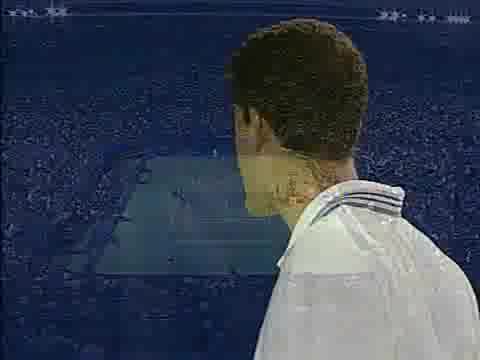
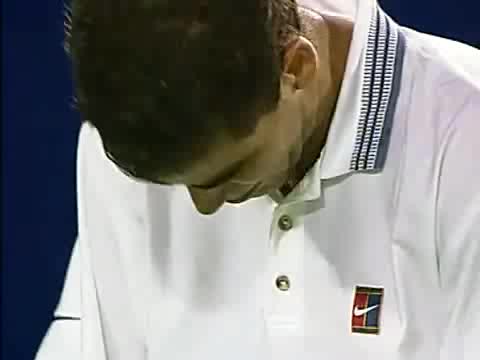


I loved this piece. Never knew this story about Pete Sampras.
Wow great read ! Thx 😉
Great piece.